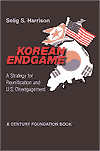| |
BOOK
REVIEW
A
Korean exit strategy for the US
Korean Endgame: A Strategy
for Reunification and US Disengagement, by
Selig Harrison
Reviewed by Sreeram Chaulia
 Selig
Harrison, one of America's finest journalists
and foreign-policy analysts, has written on
Korean politics for the past three decades. This
book is a compendium of his thoughts on ending
the convoluted 50-year regional standoff in
Northeast Asia, and a reminder that the ball is
in the US court to promote progress toward a
unified, de-nuclearized and peaceful Korea. Selig
Harrison, one of America's finest journalists
and foreign-policy analysts, has written on
Korean politics for the past three decades. This
book is a compendium of his thoughts on ending
the convoluted 50-year regional standoff in
Northeast Asia, and a reminder that the ball is
in the US court to promote progress toward a
unified, de-nuclearized and peaceful Korea.
Too often, Western commentators have taken a
myopic view of North Korea as an irrational and
belligerent "rogue state" that is the
source of all troubles. Harrison presents an
eagle-eyed historical and strategic sweep to
demonstrate that the United States shares a
large amount of blame for past tensions in the
region and that US postures have to change to
ease the path for North-South confederation and
ultimate union.
Paralysis of US policy
US military commitments in the Korean Peninsula
originated in the context of Cold War alignments
that no longer exist. Since 1958, there have
been no Chinese or Soviet troops in North Korea,
and yet the United States continues to maintain
37,000 troops backed by the latest combat
aircraft and a "nuclear umbrella" over
South Korea. The ostensible justification for US
force deployment in South Korea is the
bellicosity of the North, while in private, US
officials admit frankly that their presence is
needed to make sure that the South does not drag
the United States into a new Korean war, as
South Korean president Syngman Rhee attempted
from the late 1950s.
What Washington ignores is that as long as it
retains an adversarial role on one side of the
unfinished Korean civil war, reunification will
be impeded. Pyongyang's security concerns,
especially its fear of US fighter jets, have
been completely overlooked by Washington, which
fails to see that its nuclear and conventional
positioning in the South are considered by the
fragile and weak North as the primary threats to
its survival. US thinking is also a prisoner of
a time warp, based on the assumption that South
Koreans still see the United States as a
defender against communist aggression. Even such
a respected peacemaker as former senator George
Mitchell, whom I met last year, defended the
status quo by telling me that US forces are
"welcomed as friends" in Korea. The
potent rise of anti-US nationalist sentiment in
both South and North Korea is apparently
invisible in Washington.
Another reason for paralytic US policy is
misplaced belief that North Korea will collapse
as a state and be absorbed by the South.
Harrison opposes temporizing on redeployment of
US troops because "North Korea would
survive as a separate state for the indefinite
future" (p 4). North Korean self-image is
founded on pride in having survived an unequal
encounter with the most technically advanced
power in the world from 1950-53. Kim Il-sung's
nationalist credentials as an inveterate
anti-Japanese guerrilla fighter coupled with
five decades of statist education emphasizing
total loyalty to the nation have laid a strong
ideological foundation for North Korea's
survival. "It would be a mistake to
underrate the underlying strength of nationalist
feeling in North Korea" (p 20). Kim Jong-il
has also begun a series of "economic
reforms by stealth", ensconcing technocrats
in charge of liberalization, allowing private
farming and opening up trade and investment
links with the South. In Harrison's estimation,
the North Korean regime will "muddle
through" for many years to come by playing
off pragmatists against conservatives. The
United States cannot keep banking indefinitely
on naive hopes of Pyongyang's collapse.
Reformulating the US role
The future role of the United States will have a
critical impact on North-South normalization and
transition to unification. North Korea is wary
of Kim Dae-jung's "Sunshine Policy",
inter alia due to the outgoing South Korean
president's advocacy of a continued US military
presence in Korea after reunification. The
"gap between atmospherics and reality"
over the Sunshine Policy can be explained by
America's failure to relax economic sanctions or
accord normal trade status to the North, as was
promised in the 1994 nuclear-freeze agreement.
Kim Jong-il expected the June 2000 summit to
produce improved North Korean relations with
Washington, but the George W Bush
administration's hardline approach has now
pushed Pyongyang to lock up significant
North-South contacts.
Beyond minor issues such as economic aid,
diplomatic recognition and regret for the US
role in dividing Korea, what North Korea wishes
is for Washington gradually to downsize its
open-ended military presence, which sustains a
"climate of indefinite confrontation".
Coming down one step from its previous demand
for absolute and immediate US military
disengagement from the South, Pyongyang has
indicated that it would "not object to the
continuation of a modified US-force presence for
a transition period when arms-control tradeoffs
are explored" (p 115).
A revision of "Op Plan 5027", the US
war contingency scenario in Korea, visualizes a
massive attack using US air superiority to
"abolish North Korea as a functioning state
and reorganize the country under South Korean
control". US refusal to shelve its right to
first-use of nuclear weapons for deterring
conventional North Korean advances, together
with warnings by US generals of launching
preemptive nuclear attacks with B-52 bombers if
the North conducts war exercises near the
Demilitarized Zone, have raised Pyongyang's
determination to negotiate a change in US
postures and "tripwire" deployments,
in return for guarantees of ending the North's
nuclear and missile programs.
On the issue of formally ending the Korean War
too, unless the United States ceases to be
technically at war with the North, no headway
can be made. Harrison recommends that the US
sign a direct bilateral agreement with North
Korea for ending the armistice and then inviting
the South to join in the new peace structure as
a full partner. This accords with the historical
fact that South Korea never signed the 1953
armistice.
Obstacles to US disengagement
Harrison points with acuity to a number of
hurdles blocking a transformation of the US role
from a combatant to a neutral "honest
broker" between North and South. The
psychological legacy of the Korean War has
resulted in an exaggerated imagery of North
Korea as a demonic new "yellow peril"
in American eyes. South Korea has also lobbied
intensely against the North by roping in
sympathizers in the Pentagon, Congress and US
defense industries that have a stake in
continued militarization of Korea. Another
irritant is the "semi-imperial trappings of
US military life in Korea", where four-star
generals command a country's army and enjoy
unparalleled personal privileges. For Korea to
have peace, war-economy interests will have to
be smashed by a bold and visionary US president.
North Korean nuclear and missile proliferation
have helped hawks in Seoul and Washington to
argue against any compromise or negotiation with
a member of the "axis of evil". But
Harrison shows that this puts the cart before
the horse, since North Korea's nuclear ambitions
were "propelled from the start by the US
nuclear posture towards the peninsula" (p
197). North Korea has repeatedly asked
"formal US assurances to the DPRK
[Democratic Republic of Korea] against the
threat or use of nuclear weapons by the United
States". Pyongyang promised US envoy Robert
Galucci its suspension of withdrawal from the
nuclear Non-Proliferation Treaty in early 1994
only after he publicly declared "assurance
against the threat or use of force against the
DPRK, including nuclear weapons". Former US
president Jimmy Carter's landmark deal later
that year for temporarily freezing the North's
nuclear program also succeeded "precisely
because he was not associated with the
counterproductive threat of sanctions and
preemptive nuclear strikes" (p 215).
The 1998 moratorium on Pyongyang's missile
testing was similarly premised on reciprocal US
gestures of normalization, although both Koreas
have to consider a US-independent fear of
Japanese missile development and plutonium
reprocessing. "A unified Korea would be
defenseless if Japan should convert its civilian
nuclear and space programs to military
purposes" (p 246). It is in Northeast Asian
and US interests to persuade Japan not to start
a "trilateral nuclear race" with North
and South Korea (the South's atomic and missile
capabilities far exceed the North's).
Preserving a neutral and secure Korea
In the concluding section, Harrison takes issue
with the oft-cited statement that if the United
States disengages and militarily quits the
Korean Peninsula, regional great powers such as
Japan, China and Russia will overrun unified
Korea to fill the "power vacuum".
Struggle among neighboring powers for dominance
over Korea is indeed a sad fact of history,
somewhat like Poland's, but Harrison avers that
the objective conditions inside Korea have
changed a lot in the last hundred years, making
it impossible for a repeat of the 1894-1905
experience. The rise of powerful nationalist
sentiment in both North and South will render a
unified regime "less vulnerable to foreign
manipulation than the politically quiescent and
economically underdeveloped Korea of a century
ago" (p 347). It will be extremely
difficult for giant neighbors to manipulate
internal factional divisions in a resurgent,
vigilant and unified Korea, which will claim its
own place as a major Asian power, alongside
China, India and Japan.
Nonetheless, deep mutual distrust and animosity
between Korea and Japan persist. South and North
alike share a conviction that Japan does not
want Korea to be united. Though Koreans are more
reverential to Chinese cultural influence, they
are also worried about the Manchurian land and
petroleum seabed disputes with Beijing that
could spill over into past forms of Chinese
dominance in the peninsula. Russia is also
dismayed by its marginalization from Korean
affairs since 1991 and is eyeing
"re-entering" Korea economically to
safeguard Moscow's geopolitical interests in
Northeast Asia.
To offset any danger to Korean independence,
Harrison wants the United States to initiate a
broader security dialogue with the three big
neighbors, involving agreements not to deploy
military forces, missiles or weapons of mass
destruction in unified Korea. But for this offer
to be a serious one, Washington has to begin
reforming its own policy and implement the
disengagement steps outlined earlier in this
review. An egotistic, biased and one-sided
approach in Washington cannot yield lasting
peace.
Written at a moment when US military presence is
increasingly seen as anomalous and insulting to
national sovereignty in both North and South
Korea, Korean Endgame has a clear-cut
message: It is time for the United States to get
out of Korea and act as a regional stabilizer
rather than a destabilizing force.
Korean Endgame: A Strategy for Reunification
and US Disengagement, by Selig Harrison,
2002 Princeton University Press, ISBN:
0-691-09604-X, Price US$29.95, 409 pages.
(©2003 Asia Times Online Co, Ltd. All rights
reserved. Please contact [email protected]
for information on our sales and syndication
policies.) |
| |
|
|
 |
|



 Selig
Harrison, one of America's finest journalists
and foreign-policy analysts, has written on
Korean politics for the past three decades. This
book is a compendium of his thoughts on ending
the convoluted 50-year regional standoff in
Northeast Asia, and a reminder that the ball is
in the US court to promote progress toward a
unified, de-nuclearized and peaceful Korea.
Selig
Harrison, one of America's finest journalists
and foreign-policy analysts, has written on
Korean politics for the past three decades. This
book is a compendium of his thoughts on ending
the convoluted 50-year regional standoff in
Northeast Asia, and a reminder that the ball is
in the US court to promote progress toward a
unified, de-nuclearized and peaceful Korea.


